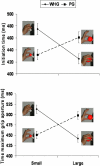Comparing natural and constrained movements: new insights into the visuomotor control of grasping
- PMID: 17971871
- PMCID: PMC2040199
- DOI: 10.1371/journal.pone.0001108
Comparing natural and constrained movements: new insights into the visuomotor control of grasping
Abstract
Background: Neurophysiological studies showed that in macaques, grasp-related sensorimotor transformations are accomplished in a circuit connecting the anterior intraparietal sulcus (area AIP) with premotor area F5. Single unit recordings of macaque indicate that activity of neurons in this circuit is not simply linked to any particular object. Instead, responses correspond to the final hand configuration used to grasp the object. Although a human homologue of such a circuit has been identified, its role in planning and controlling different grasp configurations has not been decisively shown. We used functional magnetic resonance imaging to explicitly test whether activity within this network varies depending on the congruency between the adopted grasp and the grasp called by the stimulus.
Methodology/principal findings: Subjects were requested to reach towards and grasp a small or a large stimulus naturally (i.e., precision grip, involving the opposition of index finger and thumb, for a small size stimulus and a whole hand grasp for a larger stimulus) or with an constrained grasp (i.e., a precision grip for a large stimulus and a whole hand grasp for a small stimulus). The human anterior intraparietal sulcus (hAIPS) was more active for precise grasping than for whole hand grasp independently of stimulus size. Conversely, both the dorsal premotor cortex (dPMC) and the primary motor cortex (M1) were modulated by the relationship between the type of grasp that was adopted and the size of the stimulus.
Conclusions/significance: The demonstration that activity within the hAIPS is modulated according to different types of grasp, together with the evidence in humans that the dorsal premotor cortex is involved in grasp planning and execution offers a substantial contribution to the current debate about the neural substrates of visuomotor grasp in humans.
Conflict of interest statement
Figures






References
-
- Lemon RN. The G. L. Brown Prize Lecture. Cortical control of the primate hand. Exp Physiol. 1993;78:263–301. - PubMed
-
- Tallis R. Edinburgh, UK: Edinburgh University Press; 2004. The Hand. A Philosophical Enquiry into Human Being.
-
- Napier JRJ. The prehensile movements of the human hand. J Bone Joint Surg, 1956;38B:902–913. - PubMed
-
- Rizzolatti G, Camarda L, Fogassi L, Gentilucci M, Luppino G, et al. Functional organization of inferior area 6 in the macaque monkey. II. Area F5 and the control of distal movements. Exp Brain Res. 1988;71:491–507. - PubMed
-
- Taira M, Mine S, Georgopoulos AP, Murata A, Sakata H. Parietal cortex neurons of the monkey related to the visual guidance of hand movement. Exp Brain Res. 1990;83:29–36. - PubMed
Publication types
MeSH terms
LinkOut - more resources
Full Text Sources
Miscellaneous

